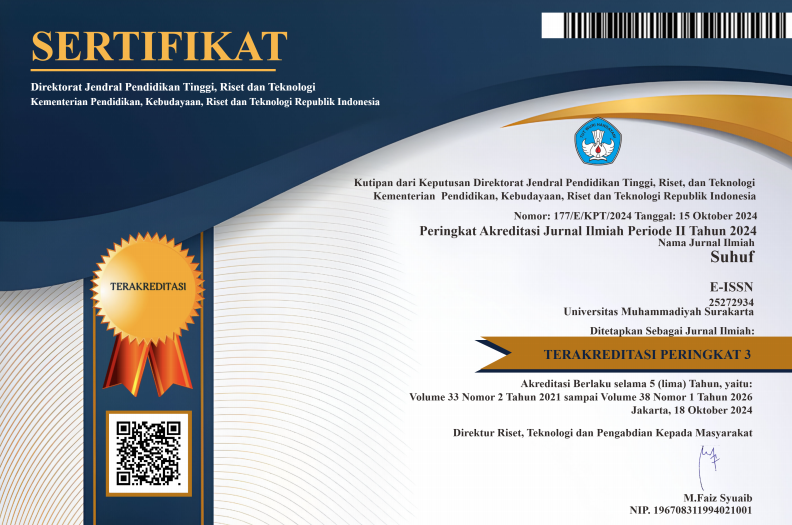Is Islamic Monetary System Possible in Indonesia? Interrelation Study between BI 7 Days Reverse Repo Rate and Nisbah Rate
DOI:
https://doi.org/10.23917/suhuf.v36i1.4339Keywords:
BI 7 Days Reverse Repo Rate, Nisbah Rate, VAR Analysis, Sharia Banks, Islamic Monetary SystemAbstract
The purpose of this study is to investigate the interrelationship between Bank Indonesia 7 Days Reverse Repo Rate (BI 7 DRRR) and Profit-Loss Sharing Rate (Nisbah Rate) in Islamic Sharia Banks (Bank Syariah Indonesia). Indonesia had been establishing conventional monetary system ever since and have yet to introduce Islamic approach to its monetary system. Now, in Islamic monetary perspective, interest rate doesn’t exist. Therefore, this research aimed to discover the possibility of Islamic approach in Indonesia’s monetary system, using Nisbah Rate launched by Islamic Sharia Banks as a substitution. The research was conducted using VAR (Vector Autoregression) to study the interrelationship between BI 7 Days Reverse Repo Rate and Nisbah Rate, using data obtained from Islamic Banking Statistics through Indonesia’s Financial Service Authority (OJK) monthly during 2021-2023. The result showed that both BI 7 Days Reverse Repo Rate and Nisbah Rate did cause impact on one another, and thus the possibility of establishing Islamic monetary system is not completely disregarded. This investigation contributes to the ongoing discourse surrounding the integration of Islamic financial principles into conventional monetary frameworks. By highlighting the reciprocal influence between conventional monetary policies and Islamic financial instruments, this study underscores the potential for a hybrid monetary system that accommodates Islamic principles within the Indonesian financial landscape.
Downloads
References
L. Winarni, “Indonesian Democracy and Islamic Religious Activities in the Age of" New Normal",” Polit. Indones. Indones. Polit. Sci. Rev., vol. 7, no. 1, pp. 98–117, 2022, doi: https://doi.org/10.15294/ipsr.v7i1.38489.
S. M. Juhro and M. Goeltom, “The Monetary Policy Regime in Indonesia,” 2015. [Online]. Available: https://papers.ssrn.com/sol3/papers.cfm?abstract_id=2875631
I. Syapriatama and I. K. Pratiwi, “Monetary Policy and Islamic Bank Stability in Indonesia,” J. Enterp. Dev., vol. 3, no. 1, pp. 1–10, 2021, doi: https://doi.org/10.20414/jed.v3i01.3367.
R. H. Ratnasari, “Understanding the Islamic Banking System in Indonesian Modern Economics Practices,” Int. J. Business, Econ. Manag., vol. 3, no. 1, pp. 212–218, 2020, doi: https://doi.org/10.31295/ijbem.v3n1.197.
S. Herianingrum and I. Syapriatama, “Dual Monetary System and Macroeconomic Performance in Indonesia,” Al-Iqtishad J. Ilmu Ekon. Syariah, vol. 8, no. 1, pp. 65–80, 2016, doi: http://dx.doi.org/10.15408/aiq.v8i1.2509.
F. Fitriasari, “The growth of Islamic banking in Indonesia,” J. Innov. Bus. Econ., vol. 3, no. 1, pp. 1–12, 2012, [Online]. Available: https://www.neliti.com/publications/11072/the-growth-of-islamic-banking-in-indonesia
P. C. Rosyadah, N. R. Arifin, R. Muhtadi, and M. Safik, “Factors That Affect Savings in Islamic Banking,” AL-ARBAH J. Islam. Financ. Bank., vol. 2, no. 1, pp. 33–46, 2020, doi: https://doi.org/10.21580/al-arbah.2020.2.1.5499.
F. Mubaroka, “The Distribution of Profits and Losses, as Well as Monetary Policy, in Islamic Banks Indonesia,” J. Ekon. Dan Bisnis Islam, vol. 9, no. 1, pp. 172 – 189, 2023, doi: https://doi.org/10.20473/jebis.v9i1.42507.
Harun, “Riba Menurut Pemikiran M. Quraish Shihab (Tela’ah Illat Hukum Larangan Riba dalam Al-Qur’an),” Suhuf Int. J. Islam. Stud., vol. 27, no. 1, pp. 38–59, 2015, doi: https://doi.org/10.23917/suhuf.v27i1.668.
A. Soemitra et al., “Analysis of Islamic Monetary Policy Transmission on Business Sector and MSME Performance,” E-Mabis J. Ekon. Manaj. dan Bisnis, vol. 22, no. 2, pp. 66–76, 2021, doi: https://doi.org/10.29103/e-mabis.v22i2.697.
M. S. A. Majid and Z. Hasin, “Islamic Banks and Monetary Transmission Mechanism in Malaysia,” J. Econ. Coop. Dev., vol. 35, no. 2, pp. 137–166, 2014, [Online]. Available: https://openurl.ebsco.com/EPDB%3Agcd%3A12%3A24744540/detailv2?sid=ebsco%3Aplink%3Ascholar&id=ebsco%3Agcd%3A97582939&crl=c
C. Choiriyah, S. Saprida, and E. Sari, “Development of Sharia banking system in Indonesia,” Mizan J. Islam. Law, vol. 5, no. 1, pp. 17–28, 2021, doi: https://doi.org/10.32507/mizan.v5i1.923.
S. Susilawati, “Analisis Penerapan Perhitungan Bagi Hasil Berdasarkan Equivalent Rate terhadap Tabungan Mudharabah pada PT. Bank Mega Syariah Kantor Cabang Pembantu Pekanbaru,” JAS (Jurnal Akunt. Syariah), vol. 3, no. 1, pp. 48–65, 2019, doi: https://doi.org/10.46367/jas.v3i1.162.
H. Haris and S. P. Astuti, “Nisbah Bagi Hasil dan Tingkat Bunga Dana Pihak Ketiga serta Pengaruhnya terhadap Produk,” SYIRKAH J. Ekon. Islam, vol. 5, no. 2, pp. 181–191, 2010, [Online]. Available: https://eprints.iain-surakarta.ac.id/id/eprint/4746
K. D. Kusumaningrum, F. Farida, and A. H. Purwantini, “Pengaruh inflasi, produk domestik bruto, BI rate, nisbah bagi hasil, dan harga emas terhadap pertumbuhan dana pihak ketiga pada bank umum syariah di indonesia,” Borobudur Account. Rev., vol. 1, no. 2, pp. 223–240, 2021, doi: https://doi.org/10.31603/bacr.6416.
E. Nurfitria and M. Meriyati, “Analisis Penentuan Nisbah Bagi Hasil terhadap Pembiayaan Mudharabah di Pt. Bprs Al-Falah Banyuasin Palembang,” Ekon. Sharia J. Pemikir. dan Pengemb. Ekon. Syariah, vol. 4, no. 1, pp. 71–84, 2018, doi: https://doi.org/10.36908/esha.v4i1.172.
A. R. Azzumi, M. Miswanto, and N. Naqiyah, “Islamic Economic Thoughts And Their Relevance in Society 5.0 Era of Zainal Abidin Ahmad,” Public Serv. Gov. J., vol. 4, no. 2, pp. 44–50, 2023, doi: https://doi.org/10.56444/psgj.v4i2.913.
OJK, “Statistik Perbankan Syariah,” 2023. [Online]. Available: https://www.ojk.go.id/id/kanal/syariah/data-dan-statistik/statistik-perbankan-syariah/default.aspx
K. R. Salman, “The Determinants of Profit-Loss Sharing Financing of Islamic Banks in Indonesia,” Muqtasid J. Ekon. dan Perbank. Syariah, vol. 13, no. 2, pp. 95–111, 2022, [Online]. Available: https://eprints.perbanas.ac.id/10024/
B. N. Asiyah, C. Islamiah, and C. I. Ningrum, “Analisis Equivalent Rate Perbankan Syariah pada Masa Pandemi (Studi pada Bank BNI Syariah),” Al-Intaj J. Ekon. dan Perbank. Syariah, vol. 8, no. 2, pp. 179–196, 2022, [Online]. Available: http://repo.uinsatu.ac.id/id/eprint/33619
Y. Ardana and W. Wulandari, “Tingkat Suku Bunga, Kinerja Keuangan, dan Bagi Hasil Deposito Pada Perbankan Syariah,” Esensi J. Bisnis Dan Manaj., vol. 8, no. 2, pp. 177–186, 2018, doi: http://dx.doi.org/10.15408/ess.v8i2.8392.
R. Noviantoro, “Analisis Faktor Nisbah dan Faktor Suku Bunga Rata-rata Kredit Modal Kerja Bank Konvensional yang Mempengaruhi Jumlah Pembiayaan Bagi Hasil pada Bank dan Unit Usaha Syariah di Indonesia Periode 2005 Sampai 2010,” EKOMBIS Rev. J. Ilm. Ekon. dan Bisnis, vol. 4, no. 1, pp. 54–64, 2016, doi: https://doi.org/10.37676/ekombis.v4i1.154.
R. Purbayati, “Evaluasi Praktek Perbankan Syariah di Indonesia: Interest Rate Free,” Ekspansi J. Ekon. Keuangan, Perbank. dan Akunt. ISSN, vol. 11, no. 2, pp. 231–250, 2019, doi: https://doi.org/10.35313/ekspansi.v11i2.1575.
L. Errico and M. Farahbaksh, “Islamic Banking: Issues in Prudential Regulations and Supervision,” International Monetary Fund, Washington, 1998. [Online]. Available: https://books.google.co.id/books?id=-ZIYEAAAQBAJ&dq=M.+L.+Errico+and+M.+M.+Farahbaksh,+Islamic+banking:+issues+in+prudential+regulations+and+supervision.+International+Monetary+Fund,+1998.&lr=&hl=id&source=gbs_navlinks_s
Z. Hasan, “Determination of Profit and Loss Sharing Ratios in Interest-Free Business Finance,” J. King Abdulaziz Univ. Islam. Econ., vol. 3, no. 1, pp. 13–29, 1985, [Online]. Available: https://papers.ssrn.com/sol3/papers.cfm?abstract_id=3079239
M. E. H. Khatat, “Monetary Policy in the Presence of Islamic Banking,” International Monetary Fund, 2016.
A. Q. A’yun and N. Fatwa, “Vector Autoregression Analysis of The Relationship Between Inflation Rate, Interest Rate, and Exchange Rate To The Jakarta Islamic Index,” J. Strateg. Glob. Stud., vol. 5, no. 1, pp. 1–19, 2022, doi: https://doi.org/10.7454/jsgs.v5i1.1095.
F. Raraga and H. Muharam, “VAR Analysis on Mutual Relationship between Stock Price Index and Exchange Rate and the Role of World Oil Price and World Gold Price,” in 11th International Annual Symposium on Management, Batu, East Java, Indonesia, 2014, pp. 756–772. doi: https://dx.doi.org/10.2139/ssrn.2470184.
A. Ascarya, H. Hasanah, and N. A. Achsani, “Perilaku Permintaan Uang dalam Sistem Moneter Ganda di Indonesia,” Bull. Monet. Econ. Bank., vol. 11, no. 1, pp. 53–88, 2008, doi: https://doi.org/10.21098/bemp.v11i1.235.
J. P. R. Suwondo, D. Kusumowati, and F. Abdullah, “Tendensi Forward Looking Behavior Dalam Kredibilitas Bank Indonesia,” J. Reg. Econ. Indones., vol. 1, no. 2, pp. 15–32, 2020, doi: https://doi.org/10.26905/jrei.v1i2.5436.
J. Suwondo, “Spillover Effect Normalisasi Kebijakan Moneter AS terhadap Indonesia,” J. Reg. Econ. Indones., vol. 4, no. 1, pp. 14–32, 2023, doi: https://doi.org/10.26905/jrei.v4i1.9944.
W. Mckibbin and R. Fernando, “Crawford School of Public Policy CAMA Centre for Applied Macroeconomic Analysis The Brookings Institution Centre of Excellence in Population Ageing Research The Global Macroeconomic Impacts of COVID-19: Seven Scenarios,” 2020. doi: https://dx.doi.org/10.2139/ssrn.3547729.

Downloads
Submitted
Accepted
Published
How to Cite
Issue
Section
License
Copyright (c) 2024 A Aswad, Juwita Purnami, Andik Pratama, Amirah Bt Mohamad Fuzi

This work is licensed under a Creative Commons Attribution 4.0 International License.


















